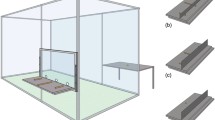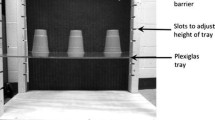Abstract
In previous studies great apes have shown little ability to locate hidden food using a physical marker placed by a human directly on the target location. In this study, we hypothesized that the perceptual similarity between an iconic cue and the hidden reward (baited container) would help apes to infer the location of the food. In the first two experiments, we found that if an iconic cue is given in addition to a spatial/indexical cue – e.g., picture or replica of a banana placed on the target location – apes (chimpanzees, bonobos, orangutans, gorillas) as a group performed above chance. However, we also found in two further experiments that when iconic cues were given on their own without spatial/indexical information (iconic cue held up by human with no diagnostic spatial/indexical information), the apes were back to chance performance. Our overall conclusion is that although iconic information helps apes in the process of searching hidden food, the poor performance found in the last two experiments is due to apes' lack of understanding of the informative (cooperative) communicative intention of the experimenter.





Similar content being viewed by others
Notes
Of course, if given enough trials many animals are able to learn to associate an arbitrary cue with the location of the food. But the point of the object choice task is that if the subject understands the meaning of the cue the experimenter is attempting to communicate, they should be successful in a very few trials – many fewer than if a totally arbitrary cue was used; for example, in Call and Tomasello (1998), using an arbitrary indexical marker, it took an average of 90 trials per subject to learn the cue.
The two gorillas were used as pilot subjects and participated in a slightly different number and order of sessions: Object distractor Photo (N'kwango, six sessions; Ruby, seven sessions), Object distractor Replica (N'kwango and Ruby, three sessions), Fruit distractor Photo (N'kwango, six sessions; Ruby, four sessions), and Fruit distractor Replica (N'kwango, five sessions; Ruby, two sessions). Two bonobos (Kuno and Ulindi) stopped participating in some sessions and these sessions were excluded from the analysis (Kuno, two sessions with the Object distractor Replica and Fruit distractor Replica; Ulindi, two sessions with the Object distractor Replica).
References
Agnetta B, Hare B, Tomasello M (2000) Cues to food location that domestic dogs (Canis familiaris) of different ages do and do not us. Anim Cogn 3:107–112
Barth J, Reaux JE, Povinelli DJ (2005) Chimpanzees' (Pan troglodytes) use of gaze cues in object choice tasks: different methods yield different results. Anim Cogn 8:84–92
Behne T, Carpenter M, Tomasello M (2005) One-year-olds comprehend the communicative intentions behind gestures in a hiding game. Dev Sci 8:492–499
Boysen ST, Berntson GG (1995) Responses to quantify: Perceptual versus cognitive mechanisms in chimpanzees (Pan troglodytes). Journal of Experimental Psychology: Animal Behavior Processes 21:82–86
Call J, Agnetta B, Tomasello M (2000) Cues that chimpanzees do and do not use to find hidden objects. Anim Cogn 3:23–34
Call J, Hare B, Tomasello M (1998) Chimpanzee gaze following in an object-choice task. Anim Cogn 1:89–99
Call J, Tomasello M (1998) Distinguishing intentional from accidental actions in orangutans (Pongo pygmaeus), chimpanzees (Pan troglodytes), and human children (Homo sapiens). J Comp Pschol 112:192–206
DeLoache JS (1987) Rapid change in the symbolic functioning of very young children. Science 238:1556–1557
DeLoache JS (1991) Symbolic functioning in very young children: understanding of pictures and models. Child Dev 62:736–752
DeLoache JS (1995) Early symbol understanding and use. In: Medin D (ed) The psychology of learning and motivation. Academic Press, New York, pp 65–114
Hare B, Brown M, Williamson C, Tomasello M (2002) The domestication of social cognition in dogs. Science 298:1634–1636
Hare B, Call J, Tomasello M (1998) Communication of food location between human and dog (Canis familiaris). Evol Com 2:137–159
Hare B, Plyusnina I, Ignacio N, Schepina O, Stepika A, Wrangham R, Trut L (2005) Social cognitive evolution in captive foxes is a correlated by-product of experimental domestication. Curr Biol 15:226–230
Hare B, Tomasello M (1999) Domestic dogs (Canis familiaris) use human and conspecific social cues to locate hidden food. J Comp Pschol 113:173–177
Hare B, Tomasello M (2004) Chimpanzees are more skilful in competitive than in cooperative cognitive tasks. Anim Behav 68:571–581
Herrmann E, Tomasello M (in press) Apes' and children's understanding of cooperative and competitive motives in a communicative situation. Dev Sci
Holm S (1979) A simple sequentially rejective multiple test procedure. Scand J Stat 6:65–70
Itakura S (1996) An exploratory study of gaze-monitoring in nonhuman primates. Jpn Psychol Res 38:174–180
Itakura S, Agnetta B, Hare B, Tomasello M (1999) Chimpanzee use of human and conspecific social cues to locate hidden food. Dev Sci 2:448–456
Itakura S, Tanaka M (1998) Use of experimenter-given cues during object-choice tasks by chimpanzees (Pan troglodytes), an orangutan (Pongo pygmaeus), and human infants (Homo sapiens). J Comp Psychol 112:119–126
Kuhlmeier VA, Boysen ST, Mukobi KL (1999) Scale-model comprehension by chimpanzees (Pan troglodytes). J Comp Psychol 113:396–402
Kuhlmeier VA, Boysen ST (2001) The effect of response contingencies on scale model task performance by chimpanzees (Pan troglodytes). J Comp Psychol 115:300–306
Kuhlmeier VA, Boysen ST (2002) Chimpanzees (Pan troglodytes) recognize spatial and object correspondences between a scale model and its referent. Psychol Sci 1:60–63
Menzel EW, Premack D, Woodruff G (1978) Map reading by chimpanzees. Folia Primatol 29:241–249
Menzel EW, Savage-Rumbaugh ES, Lawson J (1985) Chimpanzee (Pan troglodytes) spatial problem solving with the use of mirrors and televised equivalents of mirrors. J Comp Psychol 99:211–217
Miklósi A, Polgárdi R, Topál J, Csányi V (1998) Use of experimenter-given cues in dogs. Anim Cogn 1:113–121
Oden DL, Thompson RKR, Premack D (1988) Spontaneous transfer of matching by infant chimpanzees. Animal Behavior Processes 14:140–145
Parr LA, Hopkins WD, de Waal FBM (1998) The perception of facial expressions by chimpanzees (Pan troglodytes). Evol Com 2:1–23
Parr LA, de Waal FBM (1999) Visual kin recognition in chimpanzees. Nature 399:647–648
Parr LA, Winsolow JT, Hopkins WD, de Waal FBM (2000) Recognizing facial cues: individual discrimination by chimpanzees (Pan troglodytes) and rhesus monkeys (Macaca mulatta). J Comp Psychol 114:47–60
Peignot P, Anderson JR (1999) Use of experimenter-given manual and facial cues by gorillas (Gorilla gorilla) in an object-choice task. J Comp Psychol 113:253–260
Poss SR, Rochat P (2003) Referential understanding of videos in chimpanzees (Pan troglodytes), orangutans (Pongo pygmaeus), and children (Homo sapiens). J Comp Psychol 117:420–428
Povinelli DJ, Bierschwale DT, Cech CG (1999) Comprehension of seeing as a referential act in young children, but not juvenile chimpanzees. Br J Dev Psychol 17:37–60
Povinelli DJ, Eddy TJ (1996) Factors influencing young chimpanzees recognition of attention. J Comp Psychol 110:336–345
Tanaka M (2001) Discrimination and categorization of photographs of natural objects by chimpanzees (Pan troglodytes). Anim Cogn 4:201–211
Tomasello M, Call J, Gluckman A (1997) Comprehension of novel communicative signs by apes and human children. Child Dev 68:1067–1080
Tomasello M, Call J, Hare B (1998) Five primate species follow the visual gaze of conspecifics. Anim Behav 55:1063–1069
Acknowledgements
We thank the Wolfgang Köhler Primate Research Center animal caretakers for their help in collecting the data. We thank Daniel Stahl for his statistical advice. The reported experiments comply with all laws in Germany regarding animals' experiments.
Author information
Authors and Affiliations
Corresponding author
Rights and permissions
About this article
Cite this article
Herrmann, E., Melis, A.P. & Tomasello, M. Apes' use of iconic cues in the object-choice task. Anim Cogn 9, 118–130 (2006). https://doi.org/10.1007/s10071-005-0013-4
Received:
Revised:
Accepted:
Published:
Issue Date:
DOI: https://doi.org/10.1007/s10071-005-0013-4




